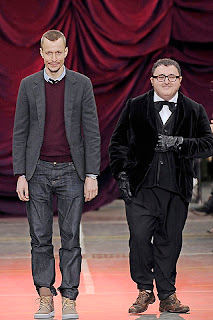Considering that the turn of the decade occurred over six months ago, I guess this post is a bit late (though I suppose I can just as easily entitle it "Top 5 most influential men's designer of the past ten years"). Anyways, the purpose of this post is
not to identify the best, most popular or even my own personal favorite men's designers over the past decade. Rather, I intend to outline the men's designers whose innovation has caused the greatest buzz in the fashion world, for better or worse.
5. Raf Simons
As a Belgian, Simons is in impressive company with his fellow compatriots (Dirk Bikkembergs, Martin Margiela, Dries Van Noten, and Ann Demeulemeester). Simons is best known for his ultra-modern, angular and highly tailored garments. The cuts and proportions are interesting and by no means conventional. His influence has grown in recent years (see for example Prada and Calvin Klein collections) and he has been appointed as creative director for the Jil Sander label.
4. Brunello Cucinelli
Though unquestionably the most questionable designer on this list, I think BC deserves to be here. The brand has brought casual, luxury Italian menswear to the fore of all upscale men's boutiques. Items currently in style such as unstructured blazers, elbow patches, suede shoes and zip-up cardigans, all have their provenance, at least in part, in Brunello Cucinelli.
3. Alber Elbaz of Lanvin
Alber Elbaz is huge and no, I'm not just talking about his rotund physique (zing!).
During the past few years, there has hardly been been a more coveted label than Lanvin. The trademarks of the label are soft, loose-fitting garments with very delicate (and often "wrinkly") fabrics. The colour palette almost always involves creamy pastels. Recent collections of other designers have followed this lead. With Lanvin, there are no bright colours, no bright lines or any hard seams. It's all one luxurious, flowing, creamy vibe. Do you dig?
2. Thom Browne
Love him or loathe him? I think for most people, it's a mixture of both. Coming from the New York scene, Tommy very quickly catapulted himself as an international fashion superstar, assisted no doubt by his zany, trippy fashion shows.
His trade-mark schoolboy look-- blazer, ankle high pants (or shorts) and clunky shoes-- has now become iconic, as has his fixation with grey, white, red, white and blue.
1. Hedi Slimane
As previously described
here, Slimane was probably the single most influential designer peddling the super slim, rocker look while serving as head creative designer for Dior men's during the better part of 2000's. In so doing, Dior's fashion shows featured a series of male models that looked more like gawky teenage girls with eating disorders.
For whatever reason, this look really took hold in the fashion world especially in the first part of the decade. By nearly single-handedly impacting men's couture by advocating a clear and recognizable fashion silhouette, Hedi Slimane is my choice as the decade's most influential designer.
.jpg)
-
-The Scandal











































.jpg)








